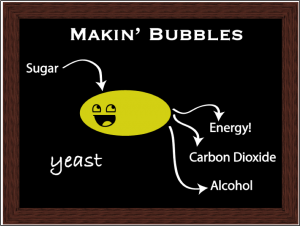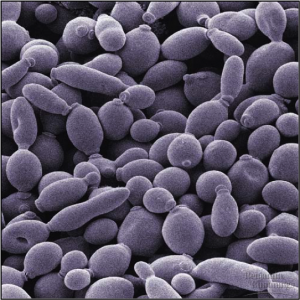By Yitong Li
What comes to your mind when you think of evolution? Giant dinosaurs with sharp fangs and powerful claws? Or giraffes stretching their necks to reach the leaves at the top of a tree? Or Charles Darwin the British gentleman with a long, dense beard? For a group of scientists in Belgium, evolution almost immediately reminds them of tipple!

Cartoon demonstration of yeast fermentation – adapted from Fermentation Lab
If you have noticed, products like bread, beer, and pizza dough all require fermentation, which is the process of converting sugar into ethanol, CO2, and desirable flavors. Fermentation doesn’t happen spontaneously, but is rather driven by microorganisms, with yeast being the most common. Yeasts are single-cell, round-shaped fungi, which make them the simplest eukaryotes. You may have come across yeast in some bread recipes as these microscopic creatures are what make our bread soft and puffy. In addition to the food industry, yeast is also used to make wine, beer, and certain spirits such as the Japanese saké. This wide application of yeast led to its domestication by our ancestors. Strange as it may sound, domesticating wild yeast is no different from domesticating the wild ancestors of our current livestock, crops, and pets. From their pets to their pizza dough, our ancestors selected the organisms that demonstrated more desirable and less unpleasant characteristics. They then bred these almost ideal organisms from generation to generation until they were satisfied with their new domesticated animal, plant, or microorganism; yeast is one example of evolution that’s driven by human selection.
In the 19th century, Pasteur’s famous swan-neck flask experiment proved that fermentation and bacterial contamination of nutrient-rich substances are not due to spontaneous generation but rather biogenesis (“all life from life”). However, even before this, early brewers, wine makers, and bakers learned to add a small portion of fermented product into unfermented food, which gave them better, faster and more predictable fermentation. Obviously, they would only keep producing the tasty fermented products and those that turned out less satisfying would soon disappear. Hence, this selective practice gradually separated industrial yeast strains from the wild strains, and the later use of pure yeast culture in our food and drink production is believed to have accelerated this separation. However, there was no direct scientific evidence for the link between human selection and yeast domestication.

Microscopic view of ale yeast used in beer production. – From brewdaddy
In the 21st century, advances in genome sequencing have allowed scientists to study evolution from a more accurate perspective. On September 8th this year, a group of Belgian scientists published their findings on yeast domestication through genome analysis in the journal Cell. For the first time in the history, we have direct and strong evidence to demonstrate that by artificially selecting the strains that have better performance in food or drink fermentation, we have driven the evolution of industrial yeasts and even the separation among different industries. For example, the 157 industrial yeast (Sccharomyces cerevisiae) strains studied in this paper are genetically separated from the wild strains and can further be divided into five sublineages based on their genome sequence: Wine, Beer 1, Beer 2, Asia, and Mixed lineage. These divisions also reflect their industrial applications and the environment that they thrive in. Compared to strains from Beer 1 lineage, those from Wine lineage generally perform much better under stress, which is likely due to their adjustment to a high-sugar, high-alcohol environment during wine-making. In contrast, beer strains demonstrate a higher capacity to metabolize maltose, which is a carbon source more commonly found in beer medium. Unlike their wild cousins, many industrial strains have lost the ability to produce 4-VG, an unpleasant molecule for drinks but much needed by yeasts to process toxic molecules in most plant cell walls. All these phenotypic shifts are vivid signs telling us how much we have shaped the yeast populations to serve our purpose better.
Small and simple as they are, yeasts have significantly contributed to our life in various aspects. In return, human selection has created a huge industrial yeast population that has adapted to the warm and nutrient-rich environment to generate more buzz for our life.
Edited by Sam Stadmiller and Tamara Vital
